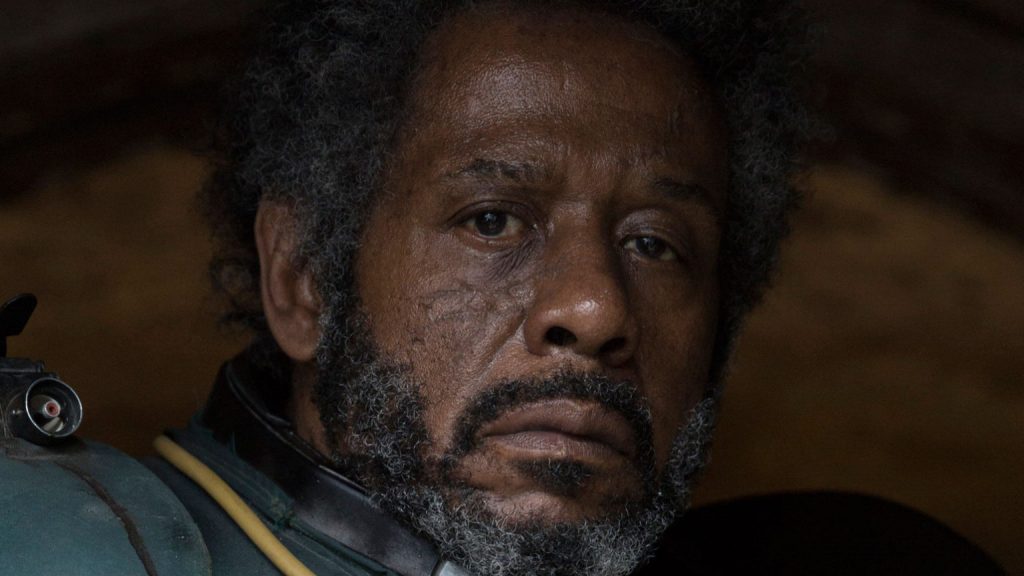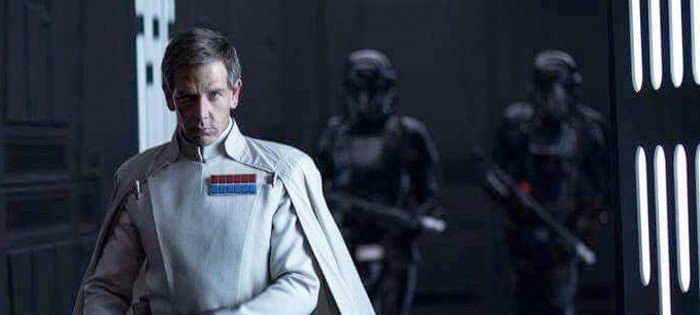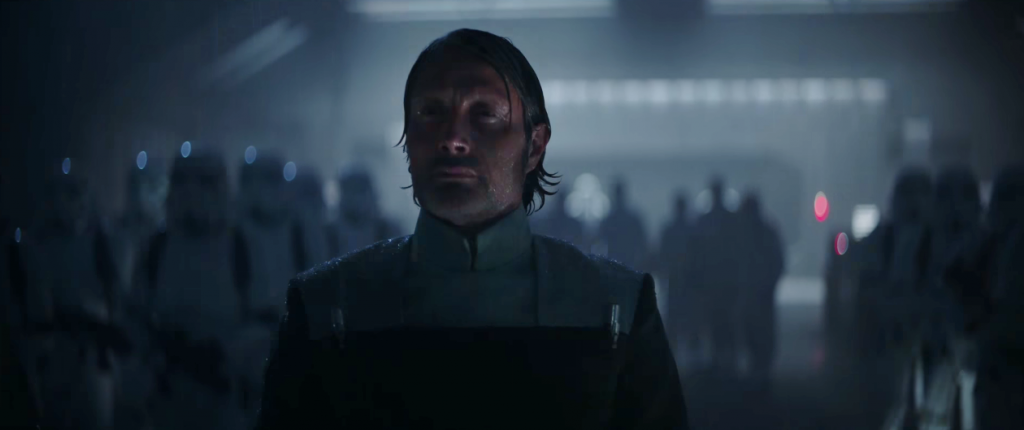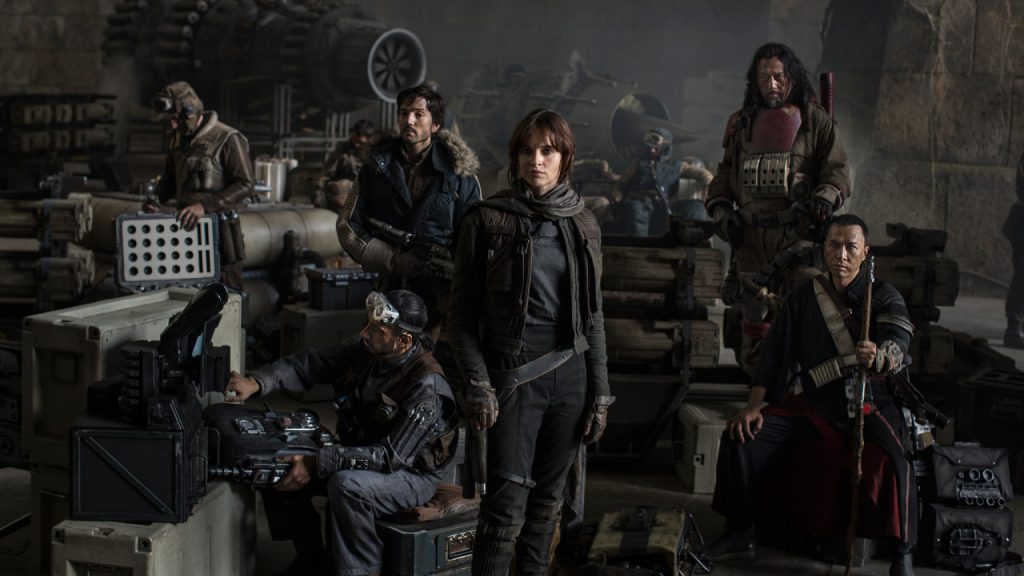some thoughts on Rogue One: The Gang
The question that Rogue One poses is “What does it mean to rebel?” Why rebel against authority? Should one rebel against all authority? What does rebellion do to one’s soul? What does conformity do to one’s soul? Why rebel when rebellion will lead to the deaths of millions, and maybe the death of you? Star Wars movies, up ’til now, have always explored the question of Empire vs Rebellion in stark black-and-white terms, but Rogue One dices up those terms, folds them over and then dices them up again before arriving at a conclusion.
some thoughts on Rogue One: Director Krennic
Before we discuss Director Krennic, let’s take a look back at the previous “bad guys” from the Star Wars universe:
First and foremost there is Darth Vader. Darth Vader starts off as “evil” in Episode IV, develops into “evil, but subservient to a greater evil” in Episode V, and, finally, “evil, but conflicted, and eventually redeemed” in Episode VI. Vader’s Terminator-like consistency was part of his appeal, it was what made him terrifying. He wore a mask, you couldn’t know what he was thinking, he destroyed anything that got in his way.
Then there is Emperor Palpatine. Emperor Palpatine is an uncomplicated climber, a man whose pursuit of power didn’t corrupt him at all, because he was evil to begin with. He started out a villainous creep and ended up as, apparently, all Sith Lords end up: killed by his own apprentice.
Then there are garden-variety bad guys like Grand Moff Tarkin, Jabba the Hutt, General Grievous and Nute Gunray, who range from sniveling pawns to grotesque monsters.
What all of them have in common is “they are bad.” In story meetings, when the producer asks “What is the antagonist’s motive?” the poor screenwriter says “He does bad things because he is bad.” That, of course, is how you know you’re writing a melodrama.
(The word “melodrama,” for non-theater-nerds, comes from the theater of early America, where people of many different linguistic backgrounds would all go to the theater to enjoy a play. Because not everyone spoke the language being used on stage, the band in the pit would cue the audience as to how to feel about different characters. A “sweet” character would be given a sweet melody, a “sinister” character would be given a sinister melody, a hero would be given a heroic melody, and so forth. Hence, “melodrama,” a dramatic form where the audience is heavily cued as to the “good and bad” of the narrative. John Williams’s music for the earlier movies used all these tricks to good effect: Luke got a yearning theme, Leia got a gentle theme, Darth Vader got an imperial march.)
The problem with this approach, of course, is that no bad guy ever thinks of himself as “the bad guy.” As Jean Renoir said, “everyone has their reasons.”
Things have improved with the re-launch of the brand and Episode VII. Kylo Ren is a genuine freak, a perverse, warped individual who is compelled to do bad things even when he doesn’t want to, who wears a mask when he doesn’t need to, who reacts with fear and confusion when his worldview is challenged.
And now we have Director Krennic, the most finely-drawn, complex villain we’ve seen yet.
some thoughts on Rogue One: Galen Erso
Of all the characters in Rogue One, Galen Erso has the most complicated motivations, which I will discuss inside.
some thoughts on Rogue One
Another Star Wars movie is released, and so the time has come for all denizens of the internet to remind the world that they would make a better Star Wars movie than anyone in Hollywood. I’ve been told that Rogue One is both too radical a departure and more of the same, that it’s both too grim and too superfluous, that its plot is both too complicated and too simple, that the story is both too esoteric and too obvious. These are the kinds of complaints that, to my mind, can only be the product of expectations. If one goes into a movie with a set of expectations and those expectations are unfulfilled, sometimes one’s response is to spend the running time looking for the movie expected instead of watching the one being screened.
But of all the complaints directed at Rogue One, the oddest one I’ve found is “the characters are thin.” This is absurd, since the characters in Rogue One are, by a long stretch, the most complex ever presented in a Star Wars movie. Generally speaking, the characters in a typical Star Wars movie are “one thing.” Obi-Wan Kenobi is “wise,” Luke Skywalker is “idealistic,” Leia is “spunky,” C-3PO is “fussy.” In 1977, Han Solo emerged as the breakout character of the series because he’s the only one who changes: he starts out as a murderous mercenary and slowly turns into a radicalized rebel. Darth Vader only becomes interesting as a character when we see him, in the original trilogy, go from being “pure evil” to being an individual caught between conflicting emotional impulses. The prequel trilogy squanders the opportunity to make Vader’s character more interesting by placing him on a straight road from “jerky kid” to “jerky teenager” to “jerky adult” before arriving finally at “victim.” The prequels are boring not because they lack plot but because Anakin Skywalker never changes. The key moment of his character arrives at the end of Episode III, when the Darth Vader mask is lowered onto his face, sealing his identity, and his destiny.
Speaking of masks and identity, the characters of Rogue One stand out in the Star Wars universe because, unlike most others, they are one thing, but they yearn to be another thing, while circumstances insist on them being a third thing. Identity is a strong theme running through Rogue One, identity and how it functions in society. One presumably knows who oneself is, but society often demands that one pretend to be someone one is not, to play a role. This happens to everyone to one extent or another, because social order otherwise disintegrates. Like Darth Vader, we all must wear masks as we play the roles of student, of employee, of spouse, of parent, of citizen. The conflicts in Rogue One emerge when characters get tired of playing their assigned roles, when they insist on expressing themselves, revealing who they “really are.”
As discussion of the Rogue One characters necessarily involves spoilers, be warned!



